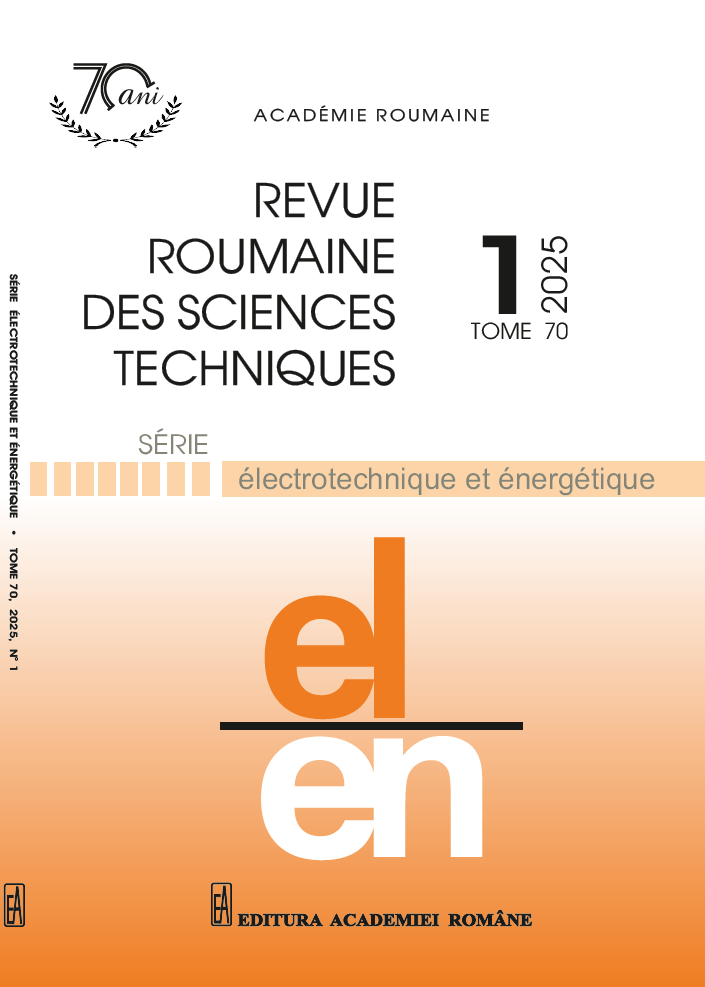AMÉLIORATION DU GAIN ET MINIMISATION DE L'ONDULATION DE L'ONDULEUR À SOURCE DIVISÉE
DOI :
https://doi.org/10.59277/RRST-EE.2025.1.14Mots-clés :
Onduleur à source divisée (SSI), Paramètres réseau, Gain, OndulationRésumé
De nombreux onduleurs CC-CA ont récemment été créés pour les systèmes solaires. L'onduleur à source divisée (SSI) gagne en popularité grâce à son fonctionnement mono-étage. Cet article présente une modification de la configuration conventionnelle (CC) du SSI en une configuration CC-CA unidirectionnelle pour un meilleur rendement, une meilleure distorsion harmonique totale (THD), une meilleure ondulation du courant d'inductance et une meilleure ondulation de la tension du condensateur. Différentes stratégies de contrôle ont été mises en œuvre pour obtenir un gain plus élevé et réduire les besoins en ondulation et en filtrage. L'environnement MATLAB/Simulink est utilisé pour l'étude de simulation, et les performances de la topologie modifiée sont comparées à celles du CC-SSI. Cet article propose d'optimiser les paramètres du réseau d'inductance et de capacité du SSI afin d'améliorer le gain et de minimiser l'ondulation à l'aide d'un modèle de réseau neuronal artificiel sous MATLAB. Le prototype matériel est construit et les résultats de simulation sont validés.
Références
(1) M.H. Rashid, Power Electronics Handbook: Devices, Circuits, and Applications, Elsevier, 3rd ed. (2011).
(2) F.Z. Peng, Z-source inverter, IEEE Trans. Ind. Appl., 39, 2, pp. 504–510 (2003).
(3) M. Murali, P. Deshpande, B. Virupurwala, P. Bhavsar, Simulation and fabrication of single phase Z-source inverter for resistive load, U.P.B. Sci. Bull., Series C, 78, 1 (2016).
(4) J. Anderson, F. Peng, A class of quasi-Z-source inverters. In Proc. IEEE Ind. Appl. Soc. Meeting, pp. 1–7 (2008).
(5) L.B. Ge, Y. Abu-Rub, R.S. Balog, F.Z. Peng, H. Sun, X. Li, An active filter method to eliminate dc-side low-frequency power for a single-phase quasi-Z-source inverter, IEEE Trans. Ind. Electron., 8, pp. 4838–4848 (2016).
(6) S. Devi, R. Seyezhai, Impedance source inverter topologies for photovoltaic applications - a review, International Journal of Electrical Engineering and Technology (IJEET), 12, 11, pp. 73–85 (2021).
(7) M.-A. Ilie, D. Floricău, Grid-connected photovoltaic systems with multilevel converters – modeling and analysis, Rev. Roum. Sci. Techn. – Électrotechn. et Énerg., 68, 1, pp. 77–83 (2023).
(8) D. Beriber, A. Talha, A. Kouzou, A. Guichi, F. Bouchafaa, Multilevel inverter for grid-connected photovoltaic systems, Rev. Roum. Sci. Techn. – Électrotechn. et Énerg., 67, 2, pp. 105–110 (2022).
(9) A. Abdelhakim, P. Mattavelli, G. Spiazzi, Three-phase split-source inverter (SSI): Analysis and modulation, IEEE Trans. Power Electron., 31, 11, pp. 7451–7461 (2016).
(10) S.S. Lee, A.S.T. Tan, D. Ishak, R. Mohd-Mokhtar, Single-phase simplified split-source inverter (S3I) for Boost DC–AC power conversion, IEEE Trans. Ind. Electron., 66, 10, pp. 7643–7652 (2019).
(11) P. Davari, F. Blaabjerg, A. Abdelhakim, P. Mattavelli, Performance evaluation of the single-phase split-source inverter using an alternative DC–AC configuration, IEEE Trans. Ind. Electron., 65, 1 (2018).
(12) O.G. Londhe, S.L. Shaikh, Analysis of the single-phase split-source inverter by using different DC AC topology, IJERT, 9 (2020).
(13) S.S. Harshad, S. Devi, R. Seyezhai, N. Harish, R. Bharath Vishal, V. Barath, Design and analysis of split-source inverter for photovoltaic systems, In IoT and Analytics in Renewable Energy Systems, CRC Press, 1, pp. 1–12 (2023).
(14) U. Devaraj, S. Ramalingam, D. Sambasivam, Evaluation of modulation strategies for single-phase quasi-Z-source inverter, J. Inst. Eng. India Ser. B, The Institute of Engineers (India) (2018).
(15) D. Umarani, R. Seyezhai, Investigation of quasi Z-source cascaded multilevel inverter for PV system with maximum power point tracking, Applied Mechanics and Materials, 622, pp. 105–110 (2014).
(16) J.I.J. Kumar, C. Sajeesh, Design and implementation of modified split source inverter with quasi sinusoidal PWM technique for stand-alone system, International Journal of Engineering Research & Technology (IJERT), 9, 1 (2020).
(17) S.E. De León-Aldaco, H. Calleja, J. Aguayo Alquicira, Metaheuristic optimization methods applied to power converters: A review, IEEE Trans. Power Electron., 30, 12, pp. 6791–6803 (2015).
(18) X. Li, X. Zhang, F. Lin, F. Blaabjerg, Artificial-Intelligence-Based Design for Circuit Parameters of Power Converters, IEEE Trans. Ind. Electron, 69, 11, pp. 11144–11155 (2022).
Téléchargements
Publiée
Numéro
Rubrique
Licence
(c) Copyright REVUE ROUMAINE DES SCIENCES TECHNIQUES — SÉRIE ÉLECTROTECHNIQUE ET ÉNERGÉTIQUE 2025

Ce travail est disponible sous licence Creative Commons Attribution - Pas d'Utilisation Commerciale - Pas de Modification 4.0 International.


